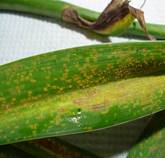Daylilies ( Hemerocallis spp. L.) are planted extensively throughout the United States and thousands of varieties have been developed. Once established in a landscape, daylilies require little maintenance, are drought tolerant, have no special pH or fertilization requirements, and are generally disease and insect free. Recently, however two diseases, Daylily Streak and Daylily Rust, have emerged that threaten the daylily industry. Daylily Rust caused by Puccinia hemerocallidis and Daylily Streak caused by Aureobasidium microstictum are easily confused. A quick diagnostic test is to run your finger along the underside of leaf lesions; an orange, powdery residue will result from the spores of Daylily Rust.
Aureobasidium microstictum

Puccinia hemerocallidis

Daylily varieties differ in susceptibility to the rust. In Massachusetts daylily rust was diagnosed on the "Twice as Nice" daylily collection. The cultivars 'Raspberry Candy' and 'All Fired Up' are the two cultivars in this line that have shown the worst symptoms, with other cultivars, such as 'Moonlight Masquerade', showing less severe symptoms. There are fourteen cultivars in this product line. Varieties in other states which have been reported to be affected since 2000 include: Attribution, Gertrude Condon, Crystal Tide, Colonel Scarborough, Starstruck, Joan Senior, Imperial Guard, Double Buttercup and Stella De Oro. Symptoms range from bright yellow spots to streaks.
Suspect Daylilies should be confirmed by a Diagnostic Lab. Contact M. Bess Dicklow at the UMass Extension Plant Diagnostic Lab at (413)545-3209, mbdicklo@umext.umass.edu . Sanitation is very important in managing this disease. Remove and destroy all infected plants. Purchase disease-free plants from reputable growers and propagate only from clean plant material. Minimize periods of leaf wetness by avoiding overhead watering and proper plant spacing. Protect uninfected plants with azoxystrobin (Heritage), propiconazole (Banner Maxx), myclobutanil (Eagle), chlorothalonil (Daconil), thiophanate-methyl (Cleary's 3336), triadimefon (Strike), or triflumizole (Terraguard). Check labels for broad crop clearance before applying fungicides.
More information and photos of daylily rust are available from the following websites:
References
- Clark, R. 2003. Daylily rust alert. Hort Notes 12(14) p 1. Univ. of Mass. Ext.
- Giesler, L. 2001. Daylily rust: a new disease in the United States . NebGuide , Univ. of Nebraska-Lincoln Coop.Ext.
- Nameth, S. 2001. Daylily rust found in Ohio . Northeast Greenhouse IPM Notes 11(10) p 4. A publication from Cornell and Rutgers Cooperative Extension.
- Riedel M. and Kobayashi H. 1999. Control of leaf streak of daylily with the use of resistance and fungicides introduction. Perennial Plant Assoc. Quar. Journal Autumn 1999, p. 11-21
- Schubert, T. 2001. New daylily disease has growers on alert. Perennial Plant Assoc. Quar. Journal. Spring 2001, p 57-58.
- Prepared by M. Bess Dicklow, UMass Plant Extension Diagnostic Lab, University of Massachusetts , Amherst , MA 01003 -9285.
Revised 12/13




0 comments
إرسال تعليق